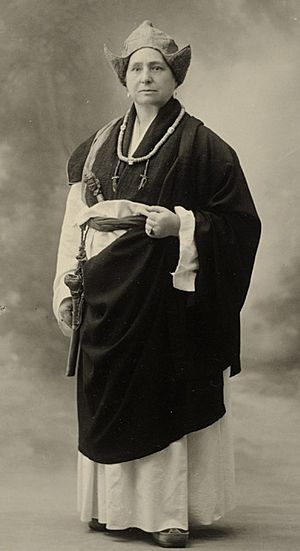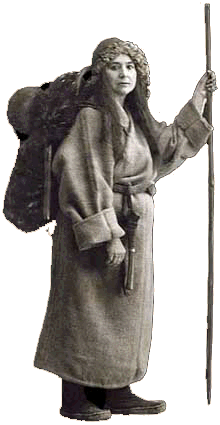Alexandra David-Néel facts for kids
Quick facts for kids
Alexandra David-Néel
|
|
|---|---|

Alexandra David-Néel in Tibet, 1933
|
|
| Born |
Louise Eugénie Alexandrine Marie David
24 October 1868 Tunis,Tunisia
|
| Died | 8 September 1969 (aged 100) |
| Nationality | Belgian and French |
| Known for | Writing on Tibet |
Alexandra David-Néel (born Louise Eugénie Alexandrine Marie David; 24 October 1868 – 8 September 1969) was an amazing Belgian-French explorer, writer, and opera singer. She was also interested in Buddhism and anarchist ideas. She is most famous for her secret trip to Lhasa, Tibet, in 1924. At that time, foreigners were not allowed to enter Lhasa.
Alexandra David-Néel wrote over 30 books about Eastern religions, philosophies, and her many travels. One of her most famous books is Magic and Mystery in Tibet, published in 1929. Her adventures and writings inspired many people, including famous writers and thinkers.
Biography
Early Life and Adventures
Alexandra David-Néel was born in 1868. When she was just two years old, her father showed her a wall where people had been executed in Paris. This early experience taught her about the harshness of human nature. A few years later, her family moved to Belgium.
Even before she was 15, Alexandra was very disciplined. She practiced strict self-control, like fasting, which she learned from stories of saints. When she was 15, she ran away from home during a holiday in Belgium. She tried to sail to England from a port in the Netherlands, but she didn't have enough money.
By the age of 18, Alexandra had already explored England, Switzerland, and Spain by herself. She also studied at the Theosophical Society, a group interested in spiritual wisdom. She joined various secret societies and was welcomed by groups supporting women's rights and anarchist ideas. She even wrote a book called For Life in 1898, which was translated into five languages.
In 1891, she visited India for the first time. There, she met a spiritual teacher named Swami Bhaskarananda Saraswati. She became interested in Buddhism and officially converted in 1889. To improve her English, she went to London and studied at the British Museum library. The next year, back in Paris, she began learning Sanskrit and Tibetan, languages important for studying Eastern cultures.
Opera Singer Career
Alexandra David-Néel studied piano and singing at the Royal Conservatory of Brussels. To help her parents, she became a lead singer at the Hanoi Opera House in Indochina from 1895 to 1897. She performed in many famous operas like La Traviata and Carmen.
After her time in Hanoi, she lived in Paris and wrote a play with a pianist named Jean Haustont. She also sang in operas in Athens and Tunis. In Tunis, she met Philippe Néel, who would later become her husband. She eventually stopped her singing career to focus on her intellectual work.
Marriage and Long Journeys
In 1904, at age 36, Alexandra married Philippe Néel. Their marriage was sometimes difficult because she loved to travel. In 1911, she left for her third trip to India, promising to return in 19 months. However, she stayed away for 14 years! She returned in 1925 with a young Lama (a Buddhist teacher) named Aphur Yongden, whom she later adopted as her son.
During her long travels, she wrote for journals and gave talks in Europe. She spoke about Buddhism, Zionism (a movement for a Jewish homeland), and radical feminism (a strong belief in women's rights).
The Indo-Tibetan Expedition
Arrival in Sikkim
Alexandra David-Néel went to India again to study Buddhism more deeply. In 1912, she arrived at a royal monastery in Sikkim, a kingdom that is now part of India. She became friends with the crown prince, Sidkeong Tulku Namgyal. She visited many Buddhist monasteries to learn more about Buddhism.
In 1914, she met 15-year-old Aphur Yongden in a monastery. He later became her adopted son and travel partner. They decided to live in a cave high in the mountains of northern Sikkim, over 4,000 meters (13,000 feet) above sea level.
Meeting the Dalai Lama
Alexandra David-Néel traveled to Kalimpong and met the 13th Dalai Lama, the spiritual leader of Tibetan Buddhism, who was in exile. This meeting happened on April 15, 1912. The Dalai Lama advised her to learn Tibetan, which she did. He was surprised and amused when she told him she was the only Buddhist in Paris!
Living in Lachen
From 1912 to 1916, she lived in Lachen, close to a great Buddhist teacher called Lachen Gomchen Rinpoche. She learned a lot from him. She lived in a cave and practiced Tibetan yoga. She learned a special technique called tummo, which helps people create internal body heat to stay warm in cold places. Because of her studies, her teacher gave her the religious name Yeshe Tome, meaning "Lamp of Wisdom." This name helped her gain respect from Buddhist leaders across Asia.
She continued to meet with Prince Sidkeong, and they discussed ways to reform and spread Buddhism. Sidkeong even helped her explore high-altitude areas of Sikkim.
First Trip to Tibet and the Panchen Lama
On July 13, 1916, Alexandra David-Néel decided to enter Tibet without permission. She went with Yongden and a monk. She visited important religious centers, including Tashilhunpo Monastery. There, she met the Panchen Lama, another important Buddhist leader. He welcomed her warmly and gave her blessings. He even offered her a place to stay, but she declined. She left with honorary titles as a Lama and a doctor in Tibetan Buddhism.
When she returned to Sikkim, the British authorities were upset that she had entered Tibet without permission. They told her she would be sent away.
Journey Through Asia
Since she couldn't return to Europe during World War I, Alexandra David-Néel and Yongden traveled to India and then Japan. In Japan, she met another explorer who had also secretly visited Lhasa. They then traveled to Korea and Beijing, China. From China, they decided to cross the country from east to west. Their long journey took several years, going through the Gobi Desert and Mongolia. They spent three years (1918–1921) at Kumbum Monastery in Tibet, where Alexandra, with Yongden's help, translated an important Buddhist text.
Secret Visit to Lhasa
In 1924, Alexandra David-Néel and Yongden decided to try to enter the "Forbidden City" of Lhasa. They disguised themselves as a beggar and a monk. Alexandra put soot on her face and wore old rags. She carried a small backpack with a compass, a pistol, and some money.
They finally reached Lhasa and blended in with a crowd of pilgrims celebrating a festival. They stayed in Lhasa for two months, visiting holy sites and large monasteries. Eventually, people became suspicious of Alexandra because she was too clean (she washed in the river every morning!). She was reported to the Governor of Lhasa. But by the time officials acted, Alexandra and Yongden had already left Lhasa.
After her return, Alexandra David-Néel became very famous. Her adventure made headlines in newspapers. She wrote a book about her journey called My Journey to Lhasa, published in 1927. Some people found her stories hard to believe, especially those about practices like levitation (floating in the air) and tummo (creating body heat).
Life in France
Back in France, Alexandra David-Néel bought a small house in Digne-les-Bains in 1928. She called it Samten-Dzong, which means "fortress of meditation." It became the first Lamaist (Tibetan Buddhist) shrine in France. Here, she wrote many books about her travels. In 1929, she published her most famous book, Mystics and Magicians in Tibet.
Later Journeys and Final Years
In 1937, at 69 years old, Alexandra David-Néel traveled to China with Yongden to study ancient Taoism. She found herself in the middle of the Second Sino-Japanese War and saw the terrible effects of war, hunger, and disease. She traveled through China for a year and a half, trying to avoid the fighting. In 1938, she went to the Tibetan town of Tachienlu for a five-year retreat. She was very sad when her husband died in 1941.
In 1945, Alexandra David-Néel returned to India and then flew back to Paris with Aphur Yongden in 1946. They then returned to her home in Digne-les-Bains.
At 78, she continued to write from her home. Sadly, Yongden died suddenly in 1955. Alexandra, who was nearly 87, was left alone. Yongden's ashes were kept at her home, waiting to be scattered in the Ganges River with her own ashes after her death.
As she got older, Alexandra David-Néel suffered from joint pain and needed crutches to walk. She slowed down her writing but continued to work. In 1959, she hired a young woman named Marie-Madeleine Peyronnet as her personal secretary. Marie-Madeleine stayed with her until the very end, caring for her like a daughter. Alexandra David-Néel lived to be 100 years old, passing away in 1969.
Legacy
In 1925, Alexandra David-Néel received an award from the Académie des sports, recognizing her incredible physical achievements during her explorations. She is considered one of the "Glories of French Sport."
In 2006, an explorer named Priscilla Telmon honored Alexandra David-Néel by recreating her journey on foot across the Himalaya. A movie called Into Forbidden Tibet was made about this expedition.
See Also
 In Spanish: Alexandra David-Néel para niños
In Spanish: Alexandra David-Néel para niños
- Atlas, a 1991 opera loosely based on David-Néel's life and writings
- Once Upon a Time... The Explorers
- Buddhism in France
- Tulpa - creations of mental powers, David-Néel claimed to have witnessed this in Tibet





